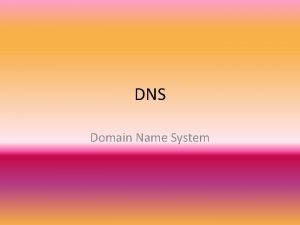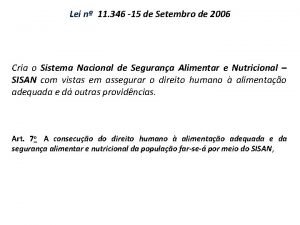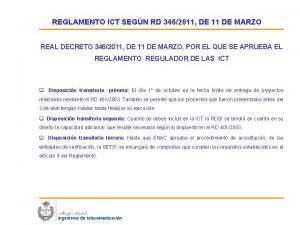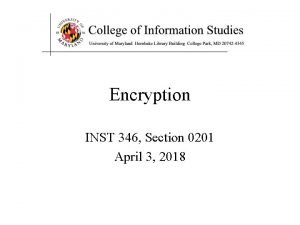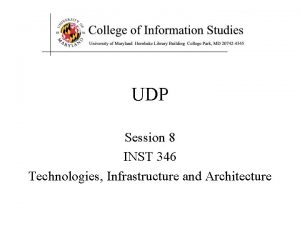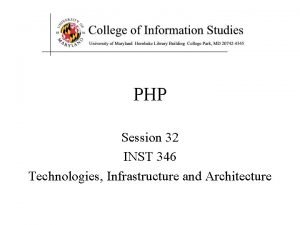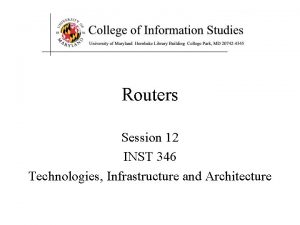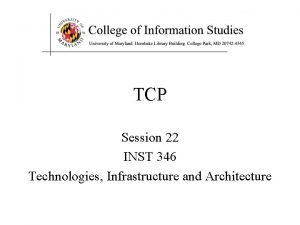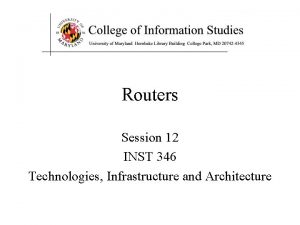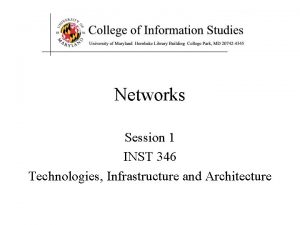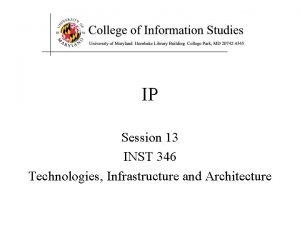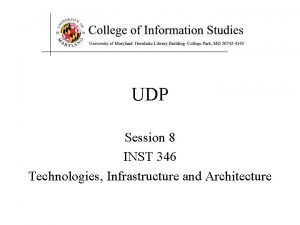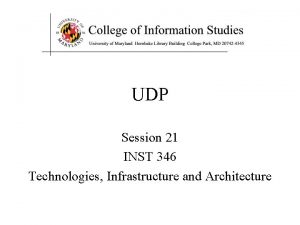DNS Session 24 INST 346 Technologies Infrastructure and

















- Slides: 17

DNS Session 24 INST 346 Technologies, Infrastructure and Architecture

DNS: Domain Name System • IP address (32 bit) used for addressing datagrams • Domain name used by humans (e. g. , www. yahoo. com) Domain Name System: • Maps between domain names and IP addresses • Distributed database implemented in hierarchy of name servers • Application-layer protocol: hosts and name servers communicate to resolve domain names

DNS: a distributed, hierarchical database Root DNS Servers … com DNS servers yahoo. com amazon. com DNS servers … org DNS servers pbs. org DNS servers edu DNS servers umd. edu DNS servers umass. edu DNS servers client wants IP for www. amazon. com; 1 st approximation: • client queries root server to find. com DNS server • client queries. com DNS server to get amazon. com DNS server • client queries amazon. com DNS server to get IP address for www. amazon. com

DNS: root name servers c. Cogent, Herndon, VA (5 other sites) d. U Maryland College Park, MD h. ARL Aberdeen, MD j. Verisign, Dulles VA (69 other sites ) e. NASA Mt View, CA f. Internet Software C. Palo Alto, CA (and 48 other sites) a. Verisign, Los Angeles CA (5 other sites) b. USC-ISI Marina del Rey, CA l. ICANN Los Angeles, CA (41 other sites) g. US Do. D Columbus, OH (5 other sites) k. RIPE London (17 other sites) i. Netnod, Stockholm (37 other sites) m. WIDE Tokyo (5 other sites) 13 logical root name “servers” worldwide • each “server” replicated many times

Local DNS name server • Each Internet Service Provider (ISP) has one – also called “default name server” • Hosts send DNS queries to their local DNS server – Answered from local cache of recent nameto-address translation pairs if possible – If not cached, obtains the translation from the DNS hierarchy

DNS name resolution example root DNS server 2 • host at cis. poly. edu wants IP address for gaia. cs. umass. edu iterated query: § contacted server replies with name of next server to contact 3 4 TLD DNS server 5 local DNS server dns. poly. edu 1 8 requesting host 7 6 authoritative DNS server dns. cs. umass. edu cis. poly. edu gaia. cs. umass. edu

DNS: caching, updating records • once (any) name server learns mapping, it caches mapping – Cache entries timeout (disappear) after some time (TTL) – TLD servers are typically cached in local name servers • Thus root name servers are not often visited • Cached entries may be out-of-date – if a DNS host changes IP address, that may not be known Internet-wide until all TTLs expire

Resource Records RR format: (name, value, type, ttl) type=A § name is hostname § value is IP address type=CNAME type=NS – name is domain (e. g. , foo. com) – value is hostname of authoritative name server for this domain § name is alias name for some “canonical” (the type=MX real) name § value is name of § value is canonical name mailserver associated § Example: www. ibm. com is with name really servereast. backup 2. ibm. com

Inserting records into DNS • example: new startup “Network Utopia” • register name networkuptopia. com at DNS registrar (e. g. , Network Solutions) – provide names, IP addresses of authoritative name server (primary and secondary) – registrar inserts two RRs into. com TLD server: (networkutopia. com, dns 1. networkutopia. com, NS) (dns 1. networkutopia. com, 212. 1, A) • create authoritative server type A record for www. networkuptopia. com; type MX

Example DNS lookup Try on your command line or terminal: nslookup www. umd. edu

Internet inter-AS routing: BGP § BGP (Border Gateway Protocol): the de facto inter-domain routing protocol • “glue that holds the Internet together” § BGP provides each AS a means to: • e. BGP: obtain subnet reachability information from neighboring ASes • i. BGP: propagate reachability information to all AS-internal routers. • determine “good” routes to other networks based on reachability information and policy § allows subnet to advertise its existence to rest of Internet: “I am here”

e. BGP, i. BGP connections 2 b 2 a 1 b 1 a 1 c 2 d AS 2 1 d AS 1 1 c 2 c ∂ e. BGP connectivity i. BGP connectivity 3 b ∂ 3 a 3 c 3 d AS 3 gateway routers run both e. BGP and i. BGP protools

BGP basics § BGP session: two BGP routers (“peers”) exchange BGP messages over semi-permanent TCP connection: • advertising paths to different destination network prefixes (BGP is a “path vector” protocol) § when AS 3 gateway router 3 a advertises path AS 3, X to AS 2 gateway router 2 c: • AS 3 promises to AS 2 it will forward datagrams towards X AS 1 AS 3 1 b 1 a 3 b 3 a 1 c AS 2 1 d 2 b 2 a 3 d 2 c 2 d 3 c BGP advertisement: AS 3, X X

BGP path advertisement AS 1 AS 3 1 b 1 a 3 a 1 c AS 2 1 d AS 2, AS 3, X 3 b 2 b 2 a AS 3, X 3 c 3 d X 2 c 2 d § AS 2 router 2 c receives path advertisement AS 3, X (via e. BGP) from AS 3 router 3 a § Based on AS 2 policy, AS 2 router 2 c accepts path AS 3, X, propagates (via i. BGP) to all AS 2 routers § Based on AS 2 policy, AS 2 router 2 a advertises (via e. BGP) path AS 2, AS 3, X to AS 1 router 1 c

BGP path advertisement AS 1 1 b 1 a AS 3, X 3 b 3 a 1 c AS 2 1 d AS 2, AS 3, X AS 3 2 b 2 a AS 3, X 3 c 3 d X 2 c 2 d gateway router may learn about multiple paths to destination: § AS 1 gateway router 1 c learns path AS 2, AS 3, X from 2 a § AS 1 gateway router 1 c learns path AS 3, X from 3 a § Based on policy, AS 1 gateway router 1 c chooses path AS 3, X, and advertises path within AS 1 via i. BGP

Hot Potato Routing AS 1 AS 3 1 b 1 a 3 a 1 c AS 2 2 b 1 d AS 1, AS 3, X 3 b 2 a 152 263 201 2 d 112 3 c 3 d X AS 3, X 2 c OSPF link weights § 2 d learns (via i. BGP) it can route to X via 2 a or 2 c § hot potato routing: choose local gateway that has least intra-domain cost (e. g. , 2 d chooses 2 a, even though more AS hops to X): don’t worry about inter-domain cost!

BGP route selection § router may learn about more than one route to destination AS, selects route based on: 1. local preference value attribute (policy decision) 2. shortest AS-PATH 3. closest NEXT-HOP router (hot potato routing)
 Domain name system nedir
Domain name system nedir Emerging technology chapter 5
Emerging technology chapter 5 It infrastructure and emerging technologies
It infrastructure and emerging technologies Emerging technology chapter 2
Emerging technology chapter 2 It infrastructure and emerging technologies
It infrastructure and emerging technologies Chapter 5 it infrastructure and emerging technologies
Chapter 5 it infrastructure and emerging technologies Ist 346
Ist 346 Byk-345
Byk-345 Cranial nerve xi
Cranial nerve xi Round off 241
Round off 241 Lei 11.346/2006
Lei 11.346/2006 598 500 rounded to the nearest ten thousand
598 500 rounded to the nearest ten thousand Ict reglamento
Ict reglamento Stats-346
Stats-346 Ley 14 346
Ley 14 346 Cipher of 346
Cipher of 346 Aafbr
Aafbr Rubiterm
Rubiterm
